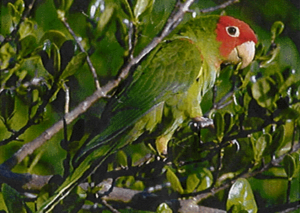It’s a lovely sunny afternoon in San Francisco. You’re walking along when suddenly you hear a loud racket coming from somewhere. Look! Up in the sky! It’s a bird! It’s a plane! It’s a parrot? You shake your head to make sure you’re not seeing things and look up again. Yup, there are about a dozen or so bright green and red birds streaking across the sky. Can this be? Parrots? In the middle of the city? Flying free?
Believe it or not, it’s true. These red-headed birds, often called cherry-headed conures, are members of the large parrot family. Parrots are colorful birds that are primarily found in warm tropical areas of the world. The cherry-heads are from western Ecuador and northern Peru. Their natural habitat is called Tropical Dry Forest, 99% of which has been destroyed. The cherry-headed conure is officially listed as “near threatened”.
This San Francisco flock was started by wild-caught birds that either escaped or were released by their owners. The first pair of cherry-headed conures began breeding in 1989 and the flock is now 40-50 in population. There is one special parrot who is a blue-crowned conure. Their territory is approximately four miles long and two miles wide. The area is called Telegraph Hill. The red-headed little squawkers live in town all year long because parrots do not migrate. They do, however, break into smaller groups in spring and summer which is the breeding season.
These funny fellows like to fight amongst themselves but tend to ignore the other birds in town. They’re kind of like people who move to a new place and never bother to get to know anyone other than family members. They’re noisy squawkers but wild parrots do not talk. Only birds in captivity talk.
Hawks are the biggest danger to the redheads. There are a large number of hawks in San Francisco. Some are passing through. Some are living there. The conures are always on the lookout for this enemy. Not surprisingly cats sometimes catch and kill one of the parrots. But the saddest danger is when human beings try to catch them and put them in cages.
Although the cherry-headed conures are from a hot and dry area, they can survive in cold temperatures because they have a down layer which grows thicker when necessary.
Parrots eat from a variety of trees including apple, pine, eucalyptus, magnolia, and cherry. Bushes and shrubs such as blackberry and strawberry are also popular. The flock in San Francisco has some loving assistance from the local residents who put out dishes of seeds for their feathered friends to feast upon.
Another interesting fact about the conures is that they do not build nests. They like to use cavities in trees which they refuse to build from scratch but will happily enlarge. Their favorite nesting tree in the Canary Island Date Palm.
San Francisco is not the only American city with its own flock of parrots. Both Chicago and San Diego report having their very own group of feathered foreigners. You might want to ask the nearest zoo in your area if they know of any flocks near your hometown. You can also find out all about the birds of Telegraph Hill on the web at www.wildparrots.com. And if you’re lucky enough to live in the Bay area, the birds roost (that means where they hang out in the trees) in a small park at Front and Jackson Streets. The park is sometimes called Jackson Square or MacArthur Park, but its real name is Walton Square. Stop by and say hello to these strange birds in a strange land!
